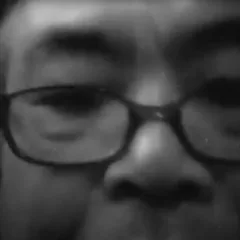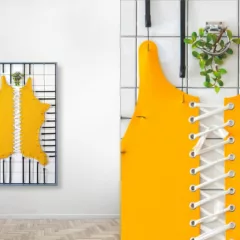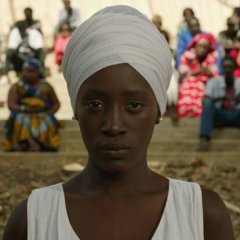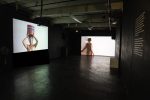This month’s Vox exhibit is nearly all video and really all pretty great! It looks like more and more video artists are part of the Vox membership, and this show reflects the shift. The only non-video in the show, a sculpture installation, is by Brent Wahl, who also makes videos. Here’s who and what:
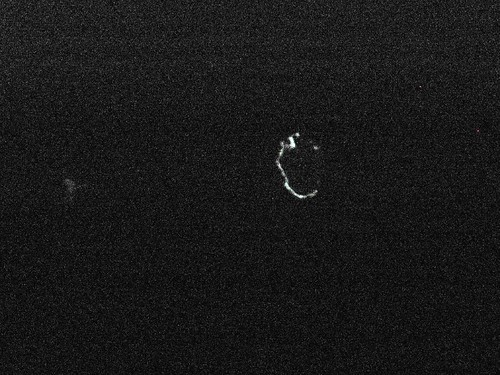
Black Hole, a video by Matthew Suib and Nadia Hironaka; I had to play with the image to show anything other than a pure black rectangle, so I’m afraid it’s a bit misleading.
The first ever collaboration between married video-makers Matthew Suib and Nadia Hironaka is a noteworthy event. (Their second collaboration is about to open Wednesday at the Ice Box at the Crane Building; this may be the only space in town big enough to house the installation’s 100-foot-long projection).
These two artists, both Vox members, are in love with the movies and each of them creates work that references the big screen. This collaboration, Black Hole, is a 7 1/2-minute noir surround-sound experience inspired by cinematic takes on imprisonment. The black box has never been blacker. The hole to the sky has never been less promising, the symbolic bird has never looked less free. The soundtrack of clanging gates and such is courtesy of Eugene Lew, Boris (Japan) and Birchville Cat Motel (New Zealand). The piece will remain up through April.
Visual deprivation was more than just the concept here. It was the actual experience. As I blinked my eyes in the penumbral room, I found myself yearning for more images, more action, just more.
I couldn’t wait to break out. This literal experience was quite successful, but being me, I’d rather skip the solitary and imagine myself in someone else’s shoes.
And that’s what the other new video installations at Vox gave me.
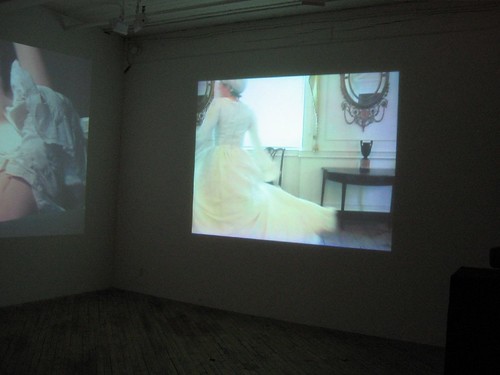
Roxana Perez-Mendez, in her two-channel video installation Larga Distancia, Memoria Corta
Vox member Roxana Perez-Mendez both curated the guest artist in the Video Lounge and projected her own work in one of the gallery spaces.
Her Larga Distancia, Memoria Corta is a larger-than-life projection of the two videos Roxana had made for her installation at the Powel House, where they were shown on small screens encased in a pair of Federal pillars installed in the historic house-museum (my post here and Roberta’s post here.

Roxana Perez-Mendez, in her two-channel video installation Larga Distancia, Memoria Corta
What a difference scale can make. Although I enjoyed the videos in their original form, I was crazy about them blown up large. The physical presence of the character that the artist plays takes on a magical quality. In her white dress as she rushes up and down the stairs, she becomes a ghost. And in the ballroom where she dances, she becomes a woman dreaming. On the bed, she turns the historical character into a living, breathing, sexy woman–Elizabeth Powel re-imagined as Perez-Mendez herself, who is searching for her own place as a Puerto Rican in the tales we tell about American history.
The light in this pair of videos comes in through the Powel House windows, casting an aura that is indirect and atmospheric and real all at once. If you missed these videos at the Powel House, catch them here. Even if you saw them there, catch them here.
Perez-Mendez, who was also thinking about what happens to history as conquerors erase the losing side of the story, selected Ricardo Miranda Zúñiga for the Video Lounge. Born of immigrant parents from Nicaragua, he, like Peres-Mendez, mixes installation and video and his own history.
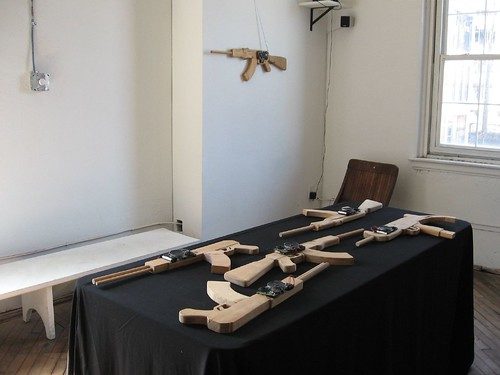
In his installation Transmitting Ideology, 20 carved wooden guns broadcast political speeches. I asked Miranda Zúñiga about the broadcasts, because most of them had run out of juice by time I got to the exhibit. He wrote:
The radio guns were broadcasting political speeches that I believe have been instrumental in constructing “Conservative” and “Liberal” ideology in the United States. The speeches included in the broadcast are by Barry Goldwater, Ronald Reagan (x2), Martin Luther King (against Vietnam speech, this was the only one I edited by dropping Vietnam and leaving war – the speech fits today’s situation to closely to not drop Vietnam), an excerpt from a debate between Buckley and Chomsky and Obama. Since people can pick up the guns and listen to them, they may be on a different frequency than the transmitter in the gallery, so you may have heard an interview on local radio.
While I heard none of the things Ricardo described, what I heard made perfect sense. I heard a commercial urging us to buy, buy, buy. In the context of Uzis and AK47s, the commercial took on an ominous tone, highlighting the politics of the culture and American consumerism and how they relate to violence. I would have liked to hear some of the political transmissions. Oops. Everything is political. The radio guns, which you can pick up and handle, turned out to be successful, even if they transmitted something the artist hadn’t scripted!
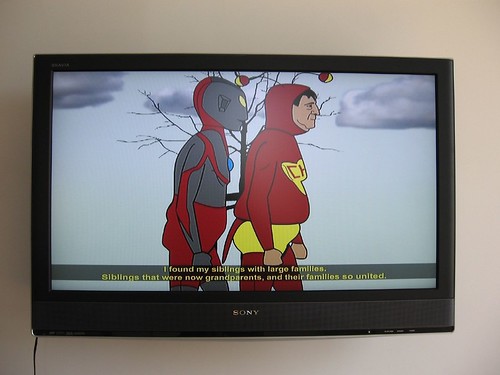
Ricardo Miranda Zúñiga, Arbol Torcido (Twisted Tree). Here the superhero on the right tells the other about his sense of dislocation on returning to visit his native land.
Miranda Zuniga’s animated video, Arbol Torcido (Twisted Tree), set in the future, is of conversation between two superheroes, one of whom left his homeland. He tells the other about visiting the family he left behind. As Thomas Wolfe wrote in Look Homeward Angel, you can’t go home again. The video is poignant and painful, the visuals delightful.
You can view it online at http://ambriente.com/carreta_nagua/. It was originally presented as part of a sculptural performance piece in Mexico City.
Part of what I like about both Miranda Zuniga and Perez-Mendez is not just the outsider voice, but the clarity of their concerns as they juxtapose their dual national identities. They are using videos to tell a narrative that’s their own story and at the same time, everyone’s story. We are all trying to figure out how we fit in and where we come from.

Brent Wahl, Interplanetary Death Star
The only non-video was presented by Brent Wahl, who has created a room-size architectural installation Interplanetary Death Star–the skeletal framework, wrapped in aluminum foil, of a sort of stadium/parking lot/spaceship.
I liked the scale and I loved the low-tech material.

Brent Wahl, Interplanetary Death Star, detail
Small, colored square images hung from all over the framework, populating it with laminated photos of people, messages and symbols. It felt like Wahl’s Death Star is channeling all the voices, all the ideas, and carrying them through space–or cyberspace. The aluminum foil reminds me of all the crackpots receiving messages from outer space through their fillings.
I also liked that Wahl gave credit to the crew who wrapped the aluminum foil. Vito Acconci was the first artist I remember who posted the names of his work-crew on his installations. Everyone should be doing this.
Held over from February are the videos by guest artist Jason Schiedel, reinstalled in a different gallery space, and by Deborah Stratman, in Screening, the video space developed within Vox by Hironaka and Suib. I have to add that Stratman’s video and the collaboration by Hironaka and Suib seem to be having a nice chat. I posted on those here.


